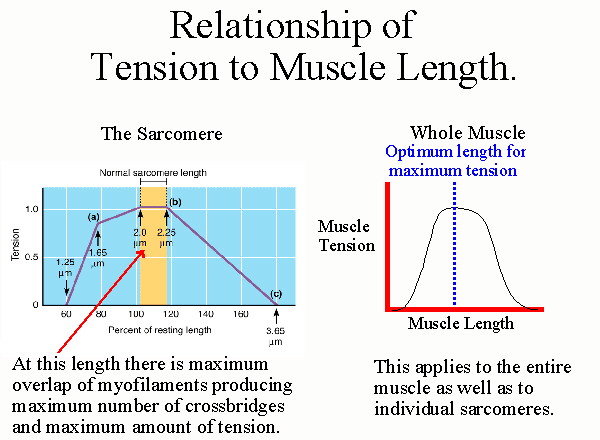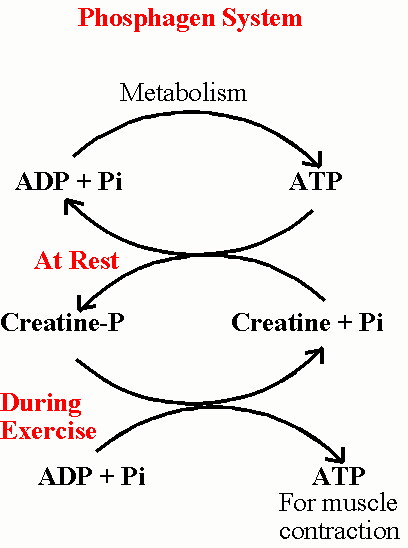

Click on images for a larger view.
|
Graded Contractions and Muscle Metabolism | |
| The muscle twitch is a single response to a single stimulus. (See Figure 9.13 a) Muscle twitches
vary in length according to the type of muscle cells involved. (See Figure 9.13 b). Fast twitch
muscles such as those which move the eyeball have twitches which reach maximum contraction in
3 to 5 ms (milliseconds). See [superior eye] and [lateral eye] These muscles were mentioned
earlier as also having small numbers of cells in their motor units for precise control. The cells in
slow twitch muscles like the postural muscles (e.g. back muscles, soleus) have twitches which
reach maximum tension in 40 ms or so. The muscles which exhibit most of our body movements
have intermediate twitch lengths of 10 to 20 ms. These three types also represents different
metabolic patterns as will be discussed later.
In a diagram of the muscle twitch can be seen the latent period, the period of a few ms encompassing the chemical and physical events preceding actual contraction. [This is not the same as the absolute refractory period, the even briefer period when the sarcolemma is depolarized and cannot be stimulated. The relative refractory period occurs after this when the sarcolemma is briefly hyperpolarized and requires a greater than normal stimulus. See Refractory Periods Diagram] Following the latent period is the contraction phase in which the shortening of the sarcomeres and cells occurs. Then comes the relaxation phase, a longer period because it is passive, the result of recoil due to the series elastic elements of the muscle. | |
|
|
We do not use the muscle twitch as part of our normal muscle responses.
Instead we use graded contractions, contractions of whole muscles which
can vary in terms of their strength and degree of contraction. In fact, even
relaxed muscles are constantly being stimulated to produce muscle tone, the
minimal graded contraction possible.
Muscles exhibit graded contractions in two ways: 1) Quantal Summation or Recruitment - this refers to increasing the number of cells contracting. This is done experimentally by increasing the voltage used to stimulate a muscle, thus reaching the thresholds of more and more cells. (See Quantal Summation). In the human body quantal summation is accomplished by the nervous system, stimulating increasing numbers of cells or motor units to increase the force of contraction. 2) Wave Summation (a.k.a. frequency summation) and Tetanization- this results from stimulating a muscle cell before it has relaxed from a previous stimulus. This is possible because the contraction and relaxation phases are much longer than the refractory period. This causes the contractions to build on one another producing a wave pattern or, if the stimuli are high frequency, a sustained contraction called tetany or tetanus. (The term tetanus is also used for an illness caused by a bacterial toxin which causes contracture of the skeletal muscles.) This form of tetanus is perfectly normal and in fact is the way you maintain a sustained contraction. Treppe is not a way muscles exhibit graded contractions. (See Figure 9.15)It is a warmup phenomenon in which when muscle cells are initially stimulated when cold, they will exhibit gradually increasing responses until they have warmed up. The phenomenon is due to the increasing efficiency of the ion gates as they are repeatedly stimulated. Treppe can be differentiated from quantal summation because the strength of stimulus remains the same in treppe, but increases in quantal summation. |
 |
Length-Tension Relationship:
Another way in which the tension of a muscle can vary is due to the length-tension relationship. This relationship expresses the characteristic that within about 10% the resting length of the muscle, the tension the muscle exerts is maximum. At lengths above or below this optimum length the tension decreases. In practical terms a muscle will be its strongest at midpoint in its extensibility. For the heart, you will later learn, it means the muscle will adjust its output to normal increases in blood supply. |
 |
Muscle Metabolism [See Muscle Metabolism chart]
Muscle cells, like all others, use ATP as their energy currency. (See Figure 2.22 modified). But some muscle cells must exhibit activity levels in which they cannot make ATP as fast as it is consumed. So muscle cells have several mechanism to provide the ATP they need. The phosphagen system - this is the use of immediately available ATP. This is not from stored ATP itself, muscle cells can store only very limited amounts. It is from energy stored as the related molecule CP, creatine phosphate. Creatine phosphate can be stored and is made from ATP during periods of rest. Then during periods of high activity CP is broken down quickly and its energy converted to ATP. But this source of ATP can only supply a cell for 8 to 10 seconds during the most strenuous exercise. Creatine released during muscle activity shows up in the urine as creatinine, a combination of two creatine molecules. Training can increase the amount of creatine phosphate stored, but this alone does not increase the strength of a muscle, just the length of time before it runs out of CP, and that by only a few seconds. See [Facts About Performance Boosters] |
 |
Anaerobic glycolysis - Glycolysis is the initial way of utilizing glucose in all
cells, and is used exclusively by certain cells to provide ATP when insufficient
oxygen is available for aerobic metabolism. Glycolysis doesn't produce much
ATP in comparison to aerobic metabolism, but it has the advantage that it
doesn't require oxygen. In addition, glycolysis occurs in the cytoplasm, not
the mitochondria. So it is used by cells which are responsible for quick bursts
of speed or strength. Like most chemical reactions, glycolysis slows down as
its product, pyruvic acid, builds up. In order to extend glycolysis the pyruvic
acid is converted to lactic acid in a process known as fermentation. Lactic
acid itself eventually builds up, slowing metabolism and contributing to
muscle fatigue.
Ultimately the lactic acid must be reconverted to pyruvic acid and metabolized aerobically, either in the muscle cell itself, or in the liver. The oxygen which is "borrowed" by anaerobic glycolysis is called oxygen debt and must be paid back. Oxygen debt is partly oxygen reserves in the lungs, tissues, and myoglobin in the lungs (alactacid oxygen debt). But mostly it is the amount of oxygen which will be required to metabolize the lactic acid produced. Strength training increases the myofilaments in muscle cells and therefore the number of crossbridge attachments which can form. Training does not increase the number of muscle cells in any real way. (Sometimes a cell will tear and split resulting in two cells when healed). Lactic acid removal by the cardiovascular system improves with training which increases the anaerobic capacity. Even so, the glycolysis-lactic acid system can produce ATP for active muscle cells for only about a minute and a half. |
 |
Aerobic metabolism - ultimately, the product of glycolysis, pyruvic acid, must be metabolized aerobically. Aerobic metabolism is performed exclusively in the mitochondria. Pyruvic acid is converted to a molecule called an acetyl group and put into a pathway known as the Krebs Cycle. Energy is released in the form of ATP and, especially, as high energy electrons. These high energy electrons are sent to a process within the mitochondria known as the electron transport system which produces the vast majority of the ATP. The waste products of aerobic metabolism are CO2 and H2O. The reactant other than glucose is O2. Aerobic metabolism is used for endurance activities and has the distinct advantage that it can go on for hours. Aerobic training increases the length of endurance activities by increasing the number of mitochondria in the muscle cells, increasing the availability of enzymes, increasing the number of blood vessels, and increasing the amount of an oxygen-storing molecule called myoglobin. |
| The types of muscle cells.
Different types of cells perform the differing functions of endurance activities and speed- strength activities. There are three types, red, white, and intermediate. The main differences can be exemplified by looking at red and white fibers and remembering that intermediate fibers have properties of the other two. | |
| White Fibers
Fast twitch Large diameter, used for speed and strength. Depends on the phosphagen system and on glycolysis-lactic acid. Stores glycogen for conversion to glucose. Fewer blood vessels. Little or no myoglobin. |
Red Fibers
Slow twitch Small diameter, used for endurance. Depends on aerobic metabolism. Utilize fats as well as glucose. Little glycogen storage. Many blood vessels and much myoglobin give this muscle its reddish appearance. |
| Intermediate Fibers: sometimes called "fast twitch red", these fibers have faster action but rely more on aerobic metabolism and have more endurance. Most muscles are mixtures of the different types. Muscle fiber types and their relative abundance cannot be varied by training, although there is some evidence that prior to maturation of the muscular system the emphasis on certain activities can influence their development. | |
| The attached table lists the types of activities which involve the various phases of muscle metabolism. Also shown is the relative amount of alactacid oxygen debt (the 3 or 4 liters of available oxygen used up first) and the lactic acid oxygen debt produced after the first few minutes of strenuous exercise. There are also graphs which show the effect of diet on endurance and recovery of muscle. | |